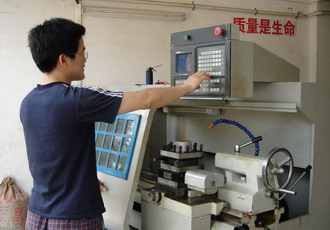
CNC lathe
3. Considerations in programming and training
(1) Programming according to process considerations, programming is to give each pass command in the step. First determine the coordinate origin of the workpiece (the center point of the right end of the handle), and calculate the coordinates of each folding point and the coordinates of the curve connection point, see the note on the part drawing. Correctly give the starting point of each step, that is, the initial position of the tool when machining a part, see N00040, N00110, N00210, N00300 and other programs in the example programming. The correctness of the starting point directly affects the formation of the programmed and contoured surface.
(2) According to the rough, finishing and selected tool division process programming, rough machining program N00040~N00200, remove most machining allowance; finishing program N00210~N00280, improve surface quality, by T01 knife (outer circle right knife) The secondary declination is 15o); the cone surface and the cutting procedure N00300 to N00340 are completed by the T02 knife (cutting knife, knife width 4 mm). Consider the actual working tool tip of the cutting knife. The influence of the tool width should be considered during programming. See the N00300, N00320 and other programs in the example programming.
(3) In the programming, the G00 program cannot be directly used to make the tool reach the surface of the workpiece. The tool and the surface of the workpiece are not allowed to move with the G00 program under zero contact. Instead, the G01 program should be used. See N00140, N00220, N00270 in the example programming. N00310 and other procedures. This effectively avoids possible collisions between the tool and the workpiece, and prevents the tool from scratching the surface of the workpiece or tool wear.
(4) Accurate tool setting, NC programming is based on the tool tip point as a reference along the contour of the part of the motion track. Before the training, the tool is first aligned correctly so that the tool nose coordinates coincide with the workpiece origin coordinates. Only in this way can the tool be correctly programmed to obtain the correct part contour.
(5) Input programming simulation, the simulation sees the contour trajectory of the simulated tool tip according to the programming. Whether the cutting edge interferes with the workpiece during the cutting process is difficult to reflect in the simulation. The simulation trajectory is correct, and the final workpiece contour is not necessarily complete. That is to say, the simulation can verify whether the programming is correct, and the overcut interference phenomenon during the machining process cannot be completely reflected.
4. Example programming
The programming of the file handle on the "GTC2E" CNC lathe is as follows.
N00010 M03 S600
N00020 G00 X60 Z20
N00030 T1 (outer round right knife, declination 15o)
N00040 G00 X16 Z2
N00050 G24 X36 W-10 F50
N00060 U-5
N00070 U-5
N00120 G00 X37 Z2
N00130 G22 L2
N00140 C00 U-31
N00150 G0l W-2 F60
N00160 G03 U15.2 W-5.5 R8
N00170 G03 U4.4 W-46.9 R85
N00180 G02 U2.4 W-17.6 R30
N00185 G01 U4
N00190 G00 W72
N00200 G80
N00210 G00 X0 S1000
N00220 G01 Z0 F40
N00230 G03 X15.2 Z-5.5 R8
N00240 G03 X19.6 Z-52.4 R85
N00250 G02 X22 Z-70 R30
N00260 G01 Z-95
N00270 G0l X26
N00280 G00 X60 Z20 S500
N00290 T2 (cutting knife, knife width 4mm)
N00300 G00 X24 Z-84
N00310 GOl X17 F30
N00320 G01 X16 Z-94
N00330 G01 X0
N00340 G00 X60 Z20
N00350 M05
N00360 M02
5 Conclusion
In summary, the numerical control training process can be summarized into the following steps: part drawing analysis → formulating the process plan → programming and input → tool setting → simulation → machining parts. In the first training, don't blindly pursue complex contoured parts, and imagine using all the programs, which is often difficult to achieve success. Instead, you should select several workpieces with representative surfaces to practice, and you can continue to change the exercises on this basis. Through the example training, it is possible to formulate the process plan, select the tool, program and process the training workpiece according to the part drawing, so as to achieve the purpose of giving one another, and get twice the result with half the effort.
Previous page
The Pm2.5 Mesh Screen is a revolutionary technology designed to filter out PM2.5 particles from the air, improving air quality and protecting human health. This innovative solution consists of a fine mesh that effectively captures and traps PM2.5 particles while allowing clean air to pass through. With its versatile applications in residential, commercial, industrial, and public settings, the Pm2.5 Mesh Screen offers a cost-effective and energy-efficient solution to combat air pollution. By understanding its significance, we can appreciate its potential to create a cleaner and healthier environment for all.
PM2.5,Mesh screen,Air pollution
Jinwu Glass Fiber Co., Ltd , https://www.jinwuwindows.com